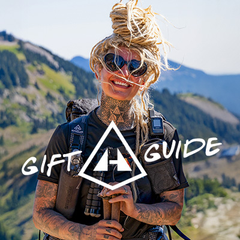Words and Photos by Rebecca Sperry
In 2015, I started hiking solo and vowed that I would never hike once the seasons began to change. By 2016, I was buying microspikes and researching cold-weather gear and haven’t looked back. There is no off-season for hiking, so long as you have the proper equipment and good decision-making skills. There is nothing quite like watching the foliage change from the middle of the wilderness, and there is no replicating the sound of snow as it squeaks under your shoes.
Fall hiking season is the perfect way to ease into winter hiking. Winter hiking season builds those leg muscles by carrying extra weight and getting you in fantastic shape for summer backpacking or a thru-hike. But what do you take when the seasons begin to change? What kinds of gear do you need to change in your kit? How do you know what to bring when the temperatures at the bottom of the mountain are several degrees higher than at the top? In the five years since I started four-season hiking, I’ve swapped gear and have my system dialed in, so let’s find out what kinds of things to bring on a hike during shoulder season.

Summer hiking (unless I’m doing an overnight) means my pack is at its most stripped-down weight, but that doesn’t mean that I don’t have everything I need. Living in New Hampshire, the summer season is a lot shorter than in the south, and temperatures on top of some of the peaks will remain at or just above freezing as late as mid-June (sometimes even later). Winter rolls in early in the Northern Presidential Range, and seeing snow as early as the beginning of September is not unheard of. Where I am headed, whether above treeline or not, has an impact on what my kit looks like, too.
I also want to caveat this by saying that 1) I make calculated risks by carrying less gear than some and 2) that building your hiking kit is a personal journey, so feel free to use my kit as an example of what you may or may not want to carry. 
DAY HIKING CONSTANTS IN EVERY SEASON
Katadyn Water Filter 2.3 oz
Bandana 1.1 oz
Baseball hat 3.4 oz
Emergency Blanket & hand warmers 5.0 oz
Emergency bivy 3.8 oz
Black Diamond headlamp & extra batteries 4.1 oz
Garmin InReach Mini 4.0 oz
Hand Sanitizer 1.3 oz
Chapstick w/ Leukotape wrapped around it 0 .4 oz
Arcteryx Zeta rain jacket 11.4 oz
Medical Kit 4.0 oz
Wallet/Headphones 4.9 oz
SUMMER ADDITIONS
Sunblock 1.8 oz
Bug spray 0.4 oz
FALL/SPRING SHOULDER SEASON ADDITIONS
Arcteryx Puffy 9.6 oz
Arcteryx Windbreaker pants 9.7 oz
North Face Thin gloves 1.6 oz
Winter hat 3.0 oz
Buff 1.0 oz
Microspikes 11.1 oz
Extra Smartwool socks 2.2 oz
WORN GEAR PER SEASON
Clothing choices based on the seasons are another very important thing to keep in mind–especially as they change.
I fell in love with Lululemon Fast and Free leggings in 2019 and haven’t looked back. I have them in 8”, 10”, 19”, and 28”. I can’t recommend them enough. Despite the pretty lofty price tag, they never cause any chaffing, they’re well made, and they dry very fast.
In the summer (or if I’m hot, which is most of the time), I wear just a sports bra when I hike. I’m a recent breast cancer survivor, and after my reconstructive surgery, I had to find a bra that zips in the front and has more support. Lots of trying and failing led me to finally finding the Under Armour High Impact racerback bra. They are very comfortable (they don’t make you look flat) and offer tons of support.

I slowly add layers as temps cool. I wear a moisture-wicking Eastern Mountain Sports t-shirt that works perfectly, and when it’s colder still, I love the Smartwool Merino 250 top. I also have an old mid-layer Eastern Mountain Sports jacket that is no longer made (sadly, because I love it). I highly recommend a mid-layer jacket. It becomes my go-to, catch-all piece for Autumn weather variables.
I wear trail runners all year (not something that I would recommend if you’re not someone who runs warm or gets cold feet easily). When the snow hasn’t fallen yet, I wear a pair of Salomon Sense Ride 4s, and when the snow arrives, I switch to the waterproof Salomon XA Pro 3D CS. I love Smartwool Ph.D. low-cut socks for summer and late spring/early fall. As temperatures cool off, I switch to Darn Tough hiker boot cushion socks.

Most importantly, the best thing to remember is that your gear will change as you figure out what works for you, and the only way to know what works and what doesn’t is to get outside. I’ve had many people tell me over the years that they’re afraid to hike in the winter or when the weather gets colder, which is a valid feeling. That being said, there are ways to get out, even if it’s not on a hike into the middle of the wilderness or up a high peak. Ease your way into it–I can assure you; it’s worth it!
Rebecca is an avid hiker based out of New Hampshire. She hikes almost exclusively solo, prefers the less-traveled trails, and when she's not hiking, she is usually writing about it. You can follow her journey on her website: rebeccasperry.com or her Instagram: @socked_in_hikes























